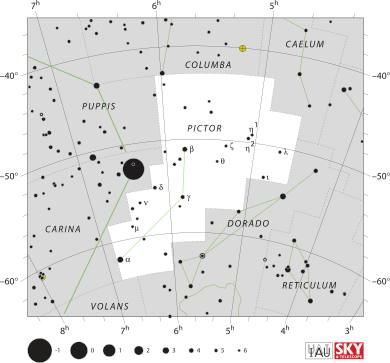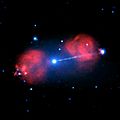Pictor facts for kids
| Constellation | |

List of stars in Pictor
|
|
| Abbreviation | Pic |
|---|---|
| Genitive | Pictoris |
| Pronunciation | genitive |
| Symbolism | Easel |
| Right ascension | 4.53h - 6.85h |
| Declination | −43° - −64° |
| Quadrant | SQ1 |
| Area | 247 sq. deg. (59th) |
| Main stars | 3 |
| Bayer/Flamsteed stars |
15 |
| Stars with planets | 6 |
| Stars brighter than 3.00m | 0 |
| Stars within 10.00 pc (32.62 ly) | 1 |
| Brightest star | α Pic (3.30m) |
| Messier objects | 0 |
| Meteor showers | 0 |
| Bordering constellations |
Caelum Carina Columba Dorado Puppis Volans |
| Visible at latitudes between +26° and −90°. Best visible at 21:00 (9 p.m.) during the month of January. |
|
Pictor is a constellation in the Southern Celestial Hemisphere, located between the star Canopus and the Large Magellanic Cloud. Its name is Latin for painter, and is an abbreviation of the older name Equuleus Pictoris (the "painter's easel"). Normally represented as an easel, Pictor was named by Abbé Nicolas-Louis de Lacaille in the 18th century. The constellation's brightest star is Alpha Pictoris, a white main-sequence star around 97 light-years away from Earth. Pictor also hosts RR Pictoris, a cataclysmic variable star system that flared up as a nova, reaching apparent (visual) magnitude 1.2 in 1925 before fading into obscurity.
Pictor has attracted attention because of its second-brightest star Beta Pictoris, 63.4 light-years distant from Earth, which is surrounded by an unusual dust disk rich in carbon, as well as an exoplanet (extrasolar planet). Another five stars in the constellation have been observed to have planets. Among them is HD 40307, an orange dwarf that has six planets orbiting it, one of which—HD 40307 g—is a potential super-Earth in the circumstellar habitable zone. Kapteyn's Star, the nearest star in Pictor to Earth, is a red dwarf located 12.76 light-years away that was found to have two super-Earths in orbit in 2014. Pictor A is a radio galaxy that is shooting an 800,000 light-year long jet of plasma from a supermassive black hole at its centre. In 2006, a gamma-ray burst—GRB 060729—was observed in Pictor, its extremely long X-ray afterglow detectable for nearly two years.
Images for kids
-
Composite image in X-rays by Chandra X-ray Observatory (blue) and radiowaves by Australia Telescope Compact Array (red) showing two lobes and a jet of plasma emanating from Pictor A
See also
 In Spanish: Pictor para niños
In Spanish: Pictor para niños




